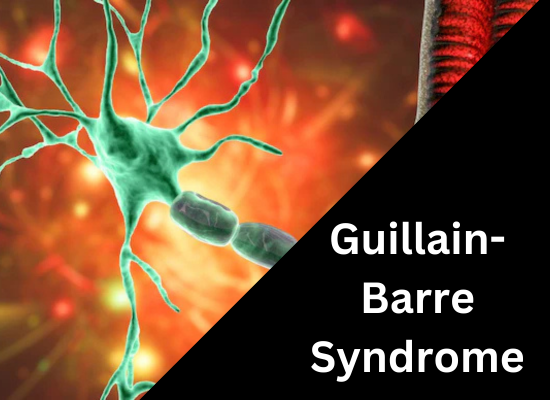Guillain-Barre Syndrome (GBS) is a rare but serious neurological disorder that affects the nerves in the body. It occurs when the immune system mistakenly attacks the peripheral nervous system, leading to muscle weakness, numbness, and even paralysis. While it can affect anyone, it is more common in adults and males. The exact cause is unknown, but it is often linked to infections like the flu, respiratory illnesses, or even recent vaccinations.
Although Guillain-Barre Syndrome can be life-threatening in severe cases, most people recover with proper medical care. Early diagnosis and treatment are crucial in managing the symptoms and preventing complications. In this comprehensive guide, we will explore the causes, symptoms, diagnosis, and treatment options for Guillain-Barre Syndrome, along with helpful recovery tips and lifestyle adjustments for those affected by this condition.
What is Guillain-Barre Syndrome?
Guillain-Barre Syndrome is an autoimmune disorder that affects the peripheral nervous system, which controls movement and sensation. When the immune system attacks the nerves, it leads to muscle weakness, tingling, and, in severe cases, paralysis.
Types of Guillain-Barre Syndrome
There are different forms of GBS, including:
- Acute Inflammatory Demyelinating Polyneuropathy (AIDP): The most common type, causing muscle weakness that starts in the lower body and spreads upward.
- Miller Fisher Syndrome (MFS): A rare form that affects eye movement and balance.
- Acute Motor Axonal Neuropathy (AMAN) and Acute Motor-Sensory Axonal Neuropathy (AMSAN): More common in Asia and Latin America, causing severe weakness.
Causes of Guillain-Barre Syndrome
The exact cause of Guillain-Barre Syndrome is unknown, but it is often triggered by infections. Some known triggers include:
Common Triggers of GBS
| Trigger | How It Can Lead to GBS |
| Respiratory infections | Can activate an immune response |
| Influenza (Flu) | Viral infections linked to GBS |
| COVID-19 | Some cases reported post-infection |
| Campylobacter bacteria | Found in undercooked poultry |
| Vaccinations (rare cases) | May trigger an autoimmune response |
| Surgery | Can cause immune system stress |
Symptoms of Guillain-Barre Syndrome
Symptoms of GBS typically develop over a few days or weeks and may start with mild sensations before worsening.
Early Symptoms:
- Tingling or numbness in hands and feet
- Weakness in legs that spreads upward
- Difficulty walking or standing
- Loss of reflexes
Severe Symptoms:
- Paralysis in arms, legs, or face
- Difficulty breathing
- Problems with speaking or swallowing
- Heart rate and blood pressure changes
Diagnosis and Medical Evaluation
Doctors use several tests to diagnose Guillain-Barre Syndrome accurately. The process typically includes:
Diagnostic Tests for GBS
| Test | Purpose |
| Nerve conduction test | Measures electrical nerve signals |
| Lumbar puncture (spinal tap) | Analyzes spinal fluid for abnormalities |
| Electromyography (EMG) | Tests muscle and nerve function |
| MRI Scan | Rules out other neurological issues |
Early diagnosis helps doctors start treatment quickly, reducing the risk of complications.
Treatment and Management
There is no cure for Guillain-Barre Syndrome, but several treatments help speed up recovery and manage symptoms.
Main Treatment Options:
- Plasmapheresis (Plasma Exchange): Removes harmful antibodies from the blood.
- Intravenous Immunoglobulin (IVIG): Infuses healthy antibodies to fight inflammation.
- Physical Therapy: Helps regain muscle strength and mobility.
- Respiratory Support: For severe cases where breathing muscles are affected.
Medications for Symptom Control:
- Pain relievers for nerve pain
- Anti-inflammatory drugs
- Blood pressure stabilizers
Guillain-Barre Syndrome Prognosis and Recovery
Most people recover from Guillain-Barre Syndrome, but the timeline varies.
Recovery Stages:
- Acute Phase (1-4 Weeks): Rapid symptom progression.
- Plateau Phase (1-3 Months): Symptoms stabilize, no worsening.
- Recovery Phase (6 Months to 2 Years): Nerves regenerate, function improves.
Possible Long-Term Effects:
- Weakness in limbs
- Fatigue and nerve pain
- Recurrence (very rare)
Living with Guillain-Barre Syndrome
Lifestyle Adjustments:
- Balanced Diet: Supports nerve repair (foods rich in B vitamins and Omega-3s).
- Physical Activity: Gradual exercise to regain strength.
- Mental Health Support: Counseling or support groups for coping strategies.
Support Resources:
- GBS/CIDP Foundation International
- Online forums and patient communities
Preventive Measures and Risk Reduction
Although Guillain-Barre Syndrome cannot always be prevented, certain steps can reduce the risk:
- Practice good hygiene to prevent infections.
- Cook poultry properly to avoid Campylobacter exposure.
- Get vaccinated, but consult a doctor if there is a history of GBS.
- Monitor post-infection symptoms for early detection.
Guillain-Barre Syndrome and Mental Health
- The emotional impact of dealing with GBS.
- Anxiety and depression in GBS patients.
- Importance of mental health support and counselling.
Recent Research and Advances in Guillain-Barre Syndrome
- Emerging Immunotherapies: New immune-modulating treatments are being explored to reduce nerve damage and improve recovery outcomes.
- Biomarkers for Early Diagnosis: Researchers are identifying specific biomarkers to enable earlier and more accurate diagnosis of GBS.
- Genetic and Environmental Risk Factors: Studies are examining genetic predisposition and environmental triggers that may contribute to GBS development.
- Plasma Exchange and IVIG Optimization: Improvements in plasmapheresis and intravenous immunoglobulin (IVIG) therapy aim to enhance their effectiveness and minimize side effects.
- Role of the Gut Microbiome: Research suggests gut bacteria may influence immune system responses linked to GBS.
Conclusion
Guillain-Barre Syndrome is a rare but serious condition that requires prompt medical attention. Early detection, proper treatment, and supportive care significantly improve recovery chances. While most people recover fully, some may experience lingering symptoms. Raising awareness and supporting research efforts can help improve the lives of those affected by this disorder.





